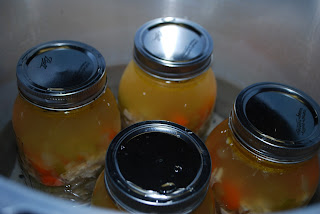For the chicken broth
I fill a big soup pot with the chicken carcass, onions, carrots, celery, pepper, parsley, garlic, and bay leaf.
Bring to a boil and continue a low boil for about 2-3 hours. Remove and discard the carcass, veggies and herbs. Strain through a strainer lined with cheese cloth. ( do this twice). Let broth cool and store in the refrigerator overnight. The next day, skim off the fat that has come to the top and solidified.
For the soup
The great thing about soup is, you can add as little or as much of the veggies and chicken that you want.
So, add your favorite diced veggies and potatoes as much as you want! Don't forget the diced chicken and the herbs. Cover by 2 inches with the chicken broth and bring to a boil and cook until the veggies are tender.
Fill hot mason jars with the hot soup leave one inch head space. Wipe the rims of the jars with a towel dampened with vinegar ( vinegar will remove the grease from the rim) . Place the lids and bands on the jars and process in a pressure canner. Be sure to follow the instructions for processing time.
Tips when preparing the soup
When you are ready to have this yummy soup for dinner or lunch, here are a couple of things you can do.
- If you like a thick soup, you can add a mix of cornstarch and water to the soup after it boils.
- Add rice or pasta after it boils cook until done.
Happy Home Canning,
Linda
I love to post pictures of the process, so here they are!

































